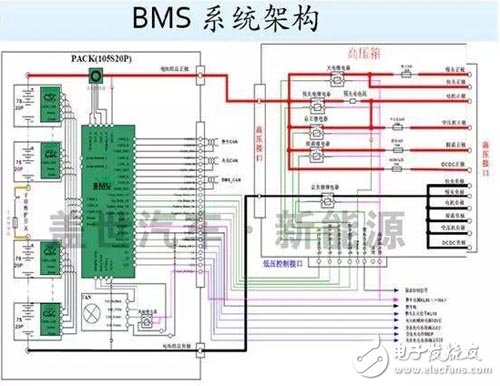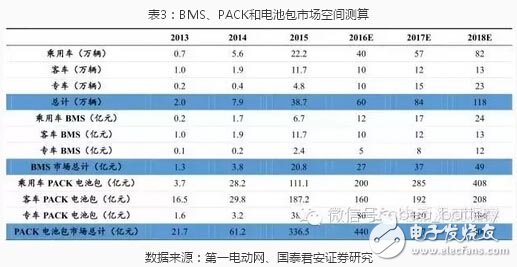1. Where is the core technology of BMS?
The core role of BMS is to ensure the safety of power batteries and improve battery life. The technology cannot be measured by one or two indicators. The key is the experience of BMS manufacturers and the understanding of the performance of corresponding models. At present, 80% of faults in new energy vehicles come from battery packs, and 80% of battery pack faults come from BMS, which shows the importance of BMS.
2. What is the difference between BMS for lithium iron phosphate and ternary battery?
Lithium iron phosphate BMS is less difficult and the ternary battery is more difficult. There are two main types of power battery options in the market: 1 ternary battery + efficient battery management system BMS, 2 lithium iron phosphate battery + relatively simple battery management system. The ternary battery has higher energy density, but its safety performance is less. It is easy to cause safety problems during overcharge and overdischarge. The ternary battery has less capacity and more quantity. When the battery inconsistency is not good enough, BMS plays a key role. Sexual effect. In other words, solving the safety problem of the ternary battery depends not only on the improvement of the quality of the battery but also on the BMS technology. Taking the CATL square as an example, the ternary battery capacity is 6~42AH, and the lithium iron phosphate battery is 50~200AH. The monomer capacity is large, and the smaller the number of battery packs of the same capacity, the technical difficulty of BMS is naturally reduced. . The Tesla battery pack uses 18650 consumer batteries, and its single-capacity capacity is only 8-10w. One battery contains more than 7000 single-cell batteries, and its BMS difficulty is self-evident.
3. What is the difference between BMS for passenger cars, passenger cars and special cars?
Bus BMS is the least difficult, followed by the special car, the passenger car is the most difficult. Passenger car body space is large, the energy requirement of the battery is low, and lithium iron phosphate is relatively safe. In 2015, 90% of passenger battery in China is lithium iron phosphate, and the corresponding BMS is also less difficult (as described in Article 2). . Passenger cars are generally operated by dedicated lines, and the shortcomings in the BMS technology can be compensated by the later services. The passenger car has a small space and requires high energy density of the battery. Most of the ternary batteries are used. In 2015, the ternary battery of the passenger car accounted for 60%, and the BMS requirements were higher. In addition, passenger car competition is relatively market-oriented, and its supplier system entry barriers and technical level requirements are also much higher than passenger cars. The ternary penetration ratio and technical grade requirements of the car are between the passenger car and the passenger car, and the BMS difficulty is also between the two.

4. What is the difference between passive equalization and active equilibrium?
Passive equalization generally uses the method of resistor heat release to release the “excessive power†of the high-capacity battery to achieve the purpose of equalization. The circuit is simple and reliable, the cost is low, but the battery efficiency is also low. When the active equalization charge is performed, the excess power is transferred to the high-capacity battery, and the excess power is transferred to the low-capacity battery during the discharge, which can improve the use efficiency, but the cost is higher, the circuit is complicated, and the reliability is low. In the future, with the improvement of the consistency of the battery cells, the demand for passive equalization may be reduced. At present, the domestic mainstream BMS plants adopt passive balance.
Table 1: Balanced technical situation of major domestic BMS plants

5. What is the unit price of BMS? What is the proportion of the entire battery pack?
The passenger car has a large battery capacity, a high voltage level, and a more expensive BMS. The unit price is about 10,000. The passenger car voltage level is lower, and the unit price of BMS is about 3000. The bus BMS unit is about 5000.
6. What is the cost of the BMS, PACK and battery of the battery pack?
Taking the 18650 battery as an example, the current price of the battery is 1.3 yuan / w, calculated according to the passenger car 25 degrees, the total price of the battery is 33,000, the price of BMS is 0.3 million, and the price of PACK is 14,000.
Figure 1: BMS and PACK cost ratio

Source: Lithium Battery and Battery Management System, Guotai Junan Securities Research
7. What is the market space for BMS, PACK and battery packs?
BMS has a lower unit price, and only BMS market space is small. In 2016, the market space is about 3 billion. However, if BMS is used as the core technology to introduce PACK, the market space is much larger. In 2016, the PACK battery pack space reached 44 billion, even After deducting the battery core, there are 14 billion market spaces.
Table 3: BMS, PACK, and Battery Pack Market Space Estimation

8. What is the development trend of the BMS industry?
At present, there are three types of companies engaged in BMS, automakers, battery factories and third-party BMSs. The representatives of domestic automakers are mainly BYD. The BMS and PACK of battery packs are mainly concentrated in the passenger car field. The technical level is relatively low. The three parties are concentrated in the field of passenger cars and special vehicles, and the technical level is obviously high. For example, Huasheng Power's founding team comes from Tesla, and its technical strength ranks among the best in China. The customer focuses on passenger cars (Jianghuai-based). Regarding the development trend of the industry, we believe that the core technology of the battery management system lies in software, and the battery core is in the electrochemical industry. It is difficult to develop software technologies such as BMS. The core competitiveness lies in the use of scale to reduce costs and provide high standards. Consistent products have big differences with the BMS and PACK industry custom attributes, and entering the BMS and PACK industries is not conducive to their advantages. A few whole-industry chain-integrated automakers can master BMS technology, and have their own production or no cost advantage. With reference to the automotive electronics industry, the entire vehicle is almost not involved in the manufacture of automotive electronics, and is completed by professional suppliers such as Bosch. We believe that in the future, BMS and PCAK will be mainly supplied by professional third-party companies and form a good cooperative relationship with OEMs.
Feyvan Electronics offers custom wiring harnesses and cable assemblies for the automotive industry, also for commercial and industrial transportation vehicle, which include cars, buses, trucks, agricultural machineries, and many other different vehicles.
We have outstanding research and development capabilities, rapid feedback of prototyping and samples, as well as manufacturing facilities for any special and custom cable assemblies even the injection molding part of assemblies.
Automotive Cable Assembly
Automotive Cable Assembly,Car Harness,Car Wiring Harness,Automotive Wiring Harness
Feyvan Electronics Technology Co., Ltd. , https://www.fv-cable-assembly.com